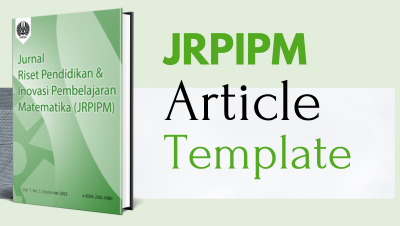Constructing Analogical Arguments in Solving Mathematical Problem: High School Students’ Interactions with ChatGPT
DOI:
https://doi.org/10.26740/jrpipm.v9n1.p31-45Keywords:
analogical arguments, Mathematical Problem Solving, ChatGPT, high school studentAbstract
solving new problems. However, many students struggle to construct well-structured arguments when solving mathematical problems, they have encountered before. The use of artificial intelligence technology, such as ChatGPT, has emerged as a potential solution to support students in building analogical arguments. This study aims to describe high school students' analogical arguments in solving mathematical problems before and after interacting with ChatGPT. This research employed a descriptive qualitative approach. The participants consisted of two 10th-grade high school students who had studied trigonometry and had prior experience using ChatGPT. The participants were selected based on the completeness of the argument components they demonstrated. Data were collected through analogical argument tasks, semi-structured interviews, and interactions with ChatGPT. Data analysis referred to indicators of analogical arguments that integrate Toulmin’s argument components and Bartha’s analogical argument structure. The results showed that students' analogical arguments changed before and after interacting with ChatGPT. The structure of the analogical arguments became more organized after the interaction. ChatGPT helped students to reconstruct the arguments they had previously built. This study implies that the use of ChatGPT can be a potential alternative to assist students in developing analogical arguments when solving mathematical problems.
References
Ali, J. K. M., Shamsan, M. A. A., Hezam, T. A., & Mohammed, A. A. Q. (2023). Impact of ChatGPT on Learning Motivation: Journal of English Studies in Arabia Felix, 2(1), 41–49. https://doi.org/10.56540/jesaf.v2i1.51
Allam, H., Dempere, J., Akre, V., Parakash, D., Mazher, N., & Ahamed, J. (2023). Artificial Intelligence in Education: An Argument of Chat-GPT Use in Education. 2023 9th International Conference on Information Technology Trends, ITT 2023, 151–156. https://doi.org/10.1109/ITT59889.2023.10184267
Amir-Mofidi, S., Amiripour, P., & Bijan-Zadeh, M. H. (2012). Instruction of mathematical concepts through analogical reasoning skills. Indian Journal of Science and Technology, 5(6), 2916-2922. http://www.indjst.orgIndianJ.Sci.Technol
Angraini, L. M., Larsari, V. N., Muhammad, I., & Kania, N. (2023). Generalizations And Analogical Reasoning of Junior High School Viewed from Bruner’s Learning Theory. Infinity Journal, 12(2), 291–306. https://doi.org/10.22460/infinity.v12i2.p291-306
Bartha, P. F. A. (2010). By Parallel Reasoning. Oxford University Press.
Berk, L. E. (2015). Child Development (C. Campanella, Ed.; 9th ed.). Pearson Education, Inc.
Chaudhry, M. A., & Kazim, E. (2022). Artificial Intelligence in Education (AIEd): a high-level academic and industry note 2021. AI and Ethics, 2(1), 157–165. https://doi.org/10.1007/s43681-021-00074-z
Corneli, J., Martin, U., Murray-Rust, D., Rino Nesin, G., & Pease, A. (2019). Argumentation Theory for Mathematical Argument. Argumentation, 33(2), 173–214. https://doi.org/10.1007/s10503-018-9474-x
Dao, X.-Q., & Le, N.-B. (2023). Investigating the Effectiveness of ChatGPT in Mathematical Reasoning and Problem Solving: Evidence from the Vietnamese National High School Graduation Examination. http://arxiv.org/abs/2306.06331
Essel, H. B., Vlachopoulos, D., Essuman, A. B., & Amankwa, J. O. (2024). ChatGPT effects on cognitive skills of undergraduate students: Receiving instant responses from AI-based conversational large language models (LLMs). Computers and Education: Artificial Intelligence, 6. https://doi.org/10.1016/j.caeai.2023.100198
Güner, P., & Erbay, H. N. (2021). Metacognitive Skills and Problem-Solving. International Journal of Research in Education and Science, 7(3), 715–734. https://doi.org/10.46328/ijres.1594
Guo, Y., & Lee, D. (2023). Leveraging ChatGPT for Enhancing Critical Thinking Skills. Journal of Chemical Education, 100(12), 4876–4883. https://doi.org/10.1021/acs.jchemed.3c00505
Hesse, F. W., & Klecha, D. (1990). Use of analogies in problem solving. Computers in Human Behavior, 6(1), 115-129. https://doi.org/10.1016/0747-5632(90)90034-E
Jagadianti, G. W., & Rosyidi, A. H. (2023). Argumentasi Analogis Siswa SMA pada Masalah Analogi Tipe Prediktif. MATHEdunesa, 12(3), 881–897. https://doi.org/10.26740/mathedunesa.v12n3.p881-897
Juthe, A. (2015). Analogical argument schemes and complex argument structure. Informal Logic, 35(3), 378-445. https://doi.org/10.22329/il.v35i3.4211
Maknun, C. L., Rosjanuardi, R., & Ikhwanudin, T. (2018). Students’ Mathematical Argumentation in Trigonometry. https://www.researchgate.net/publication/324329468
Miles, M. B., Huberman, A. M., & Saldaña, J. (2014). Qualitative Data Analysis: Sourcebook Methods. SAGE Publication.
Pakpahan, F. H., & Saragih, M. (2022). Theory Of Cognitive Development by Jean Piaget. Journal of Applied Linguistics, 2(2), 55–60. https://doi.org/10.52622/joal.v2i2.79
Racharak, T., Tojo, S., Hung, N. D., & Boonkwan, P. (2019). On Construction and Evaluation of Analogical Arguments for Persuasive Reasoning. Applied Artificial Intelligence, 33(13), 1107–1132. https://doi.org/10.1080/08839514.2019.1646026
Shodikin, A., Murniasih, T. R., Faizah, S., & Ekawati, D. W. (2023). Students’ Analogical Reasoning in Solving Geometry Problems Viewed from Visualizer’s and Verbalizer’s Cognitive Style. Jurnal Pedagogi dan Pembelajaran, 6(3), 330–338. https://doi.org/10.23887/jp2.v6i3.60960
Szmyd, K., & Mitera, E. (2024). The Impact of Artificial Intelligence on the Development of Critical Thinking Skills in Students. In European Research Studies Journal: Vol. XXVII (Issue 2). https://orcid.org/0000-0002-6016-8564
Toulmin, S. (2003). The Uses of Argument. Cambridge University Press.
Widjaja, W., Vale, C., Herbert, S., Loong, E. Y. K., & Bragg, L. A. (2021). Linking comparing and contrasting, generalising and justifying: a case study of primary students’ levels of justifying. Mathematics Education Research Journal, 33(2), 321–343. https://doi.org/10.1007/s13394-019-00306-w
Wu, H. M., Yin, T., & Chan, Y. J. (2025). Using a conversation-based agent system to foster math argumentation learning. Educational Technology Research and Development. https://doi.org/10.1007/s11423-025-10455-4
Zhai, X., Chu, X., Chai, C. S., Jong, M. S. Y., Istenic, A., Spector, M., Liu, J. B., Yuan, J., & Li, Y. (2021). A Review of Artificial Intelligence (AI) in Education from 2010 to 2020. In Complexity (Vol. 2021). Hindawi Limited. https://doi.org/10.1155/2021/8812542
Zhou, D., Liu, J., & Liu, J. (2021). Mathematical argumentation performance of sixth graders in a chinese rural class. International Journal of Education in Mathematics, Science and Technology, 9(2), 213–235. https://doi.org/10.46328/IJEMST.1177
Downloads
Published
How to Cite
Issue
Section
 Abstract views: 92
,
Abstract views: 92
, PDF Downloads: 69
PDF Downloads: 69






